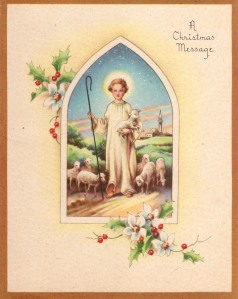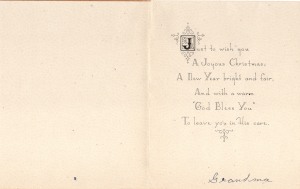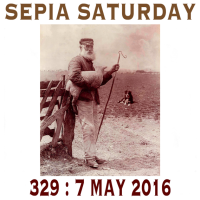This Christmas card was given to Sadie by her grandmother, but I’m not sure which one. It shows a young Jesus tending to his flocks in the countryside much like the prompt.
My maternal grandfather, Albert Westra, went to school in Holland for carpentry but when he came to America, he started out working for his brother, Herman, in the dairy industry. When Albert was finally ready to have his own herd of milk cows, he rented a number of farms in Sussex County, New Jersey. He did well for himself but things weren’t always easy. Animal husbandry has its risks. Case in point, lightning and fire seemed to follow my grandfather around.
The New Jersey Herald reprinted portions of an article on 09 June 2013 that was originally published in June of 1938:[1]
“75 Years Ago – Lightning Hits Barn, Milkers Are Shocked; Several Cows Knocked Down, Barn Was Not Burned
During the heavy thunder shower which passed over Fredon last Sunday evening, lightning struck the new barn on the farm of George Lewis. Albert Westra, who operates the farm, was at his house and saw a ball of lightning strike one of the lightning rods, badly damaging it.
At the time there were six men milking cows in the barn and three of them were shocked. One of those men felt the effects of the shock for several hours.
Six or seven cows were also knocked down, but not seriously injured. However the shock to the cows caused a drop in milk production amounting to two cans for the dairy.
Three prongs on the lightning rod were broken which is the only damage to the building. The barn is a new one, recently erected after the burning of the old barn believed to have been struck by lightning.
The new barn is equipped with a modern lightning rod system, which undoubtedly saved the building from serious damage. It is believed that the men and cows were shocked by part of the force of the lightning following the water pipes leading to the buckets at the stanchions. In the protective system the water pipes, hay fork carrier and manure carrier tracks are connected with lightning rods and grounds to protect the building from lightning striking any of these metal carriers and following them into the building.”[1]
I like the detail that milk production dropped by two cans.
But it didn’t stop with that one lightning strike! Another article was published 25 August 2013 recounting events that had happened in August of 1938. This second incident happened just a month after the lightning strike recounted above.[2]
“75 Years Ago – Ten Cows Perish in Fredon Fire
Fire of undetermined origin, but which might have been caused by spontaneous combustion, destroyed the new barn on the George E. Lewis farm in Fredon Township, operated by Westra Dairy Inc., late last Friday afternoon.
Five men were in the barn feeding the cattle when a crackling sound was heard, and burning hay was discovered falling from the mow. At the time, there were about 94 head of cattle in the barn and all but 10 were saved.
In addition to the loss of 10 cows, about 125 tons of hay, 15 tons of feed, a new hay loader, and barn equipment were destroyed.
The barn, which was 32 by 170 feet, had been in use less than a year.”
This the type of spontaneous combustion phenomena that is associated with people who just self-immolate without touching any of the objects around them. Nothing so mysterious here. When hay is baled before it completely dries there is a chance that it could catch on fire. The compaction of damp or wet hay into dense bales can create pockets of mold that grow hot enough to cause a fire. Unfortunately, in the second incident at the barn, some of the cows weren’t quite so lucky; ten of them perished in the fire but 84 were rescued.
My grandfather kept farming into the mid 1940s when he decided to move the family into Newton proper and began his construction/carpentry business. There are no reports from his daughter about any fires or lightning after they left the farm!
The concept behind these weekly Saturday posts can be found at Sepia Saturday Intro.
Theme taken from Sepia Saturday photo: Shepard with lamb
[1] “75 Years Ago – Lightning Hits Barn,” (Newton) New Jersey Sunday Herald, 09 June 2013, p. C-4, cols. 4-5. Reprint of article first appearing in 09 June 1938, current article most likely edited from the original article.
[2] “75 Years Ago – Ten Cows Perish in Fire,” (Newton) New Jersey Sunday Herald, 25 August 2013, p. C-4, col. 4. Reprint of article first appearing in 25 August 1938, current article most likely edited from the original article.




A beautiful card with a touching family story.
LikeLike
I lived on a dairy farm; I, too, was milking cows when lightning hit…I got my shock through the cow and the milking machine; it lifted me right out of my rubber boots…amazing feeling! Our cows, too, dropped production rates for a few days…
LikeLike
Yikes, right out of your boots? Did it knock you out? Glad you’re okay!
LikeLike
I think perhaps it’s a good thing your grandfather decided to leave the milk cow business! Electric shocks can do that to you – knock you right out of your boots, so to speak. Our washer & dryer were down in the basement on a bare concrete floor. One afternoon, after it had been raining, I went down to the laundry to pull something out of the dryer that was running at the time. I was standing on that slightly damp cement floor in bare feet. The last thing I remember is reaching out for the dryer door handle & my arm shaking like crazy. The next thing I knew, I was picking myself up off the floor on the far side of the room! I never went down there in bare feet again – rain, or no rain!
LikeLike
I think I would have quit doing laundry all together after an incident like that!!
LikeLike
And they say lightning never strikes in the same place twice! Dangerous business milking cows 🙂
LikeLike
A perfect card for the prompt. With livestock generally out in all weathers, I would think there must be quite a lot of lightning strikes regularly hitting them worldwide.
LikeLike